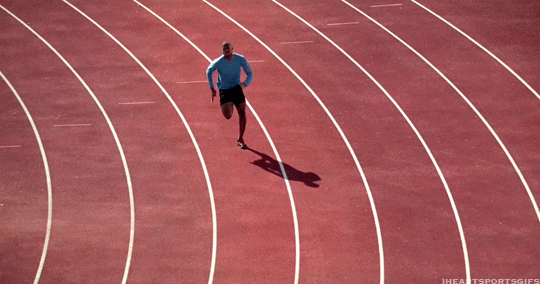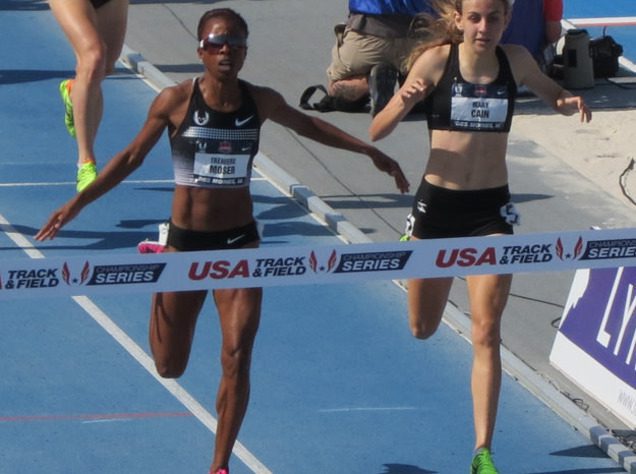It goes without saying, but endurance races are different from sprinting in that they thoroughly require both the aerobic and anaerobic energy systems. Distance runners cannot run top speed for the entire race, as it’s just not physically possible. They need to be able to cope with a different type of fatigue, one that is longer and drawn out through the duration of the event. Additionally, distance runners have to think about mental tactics to give them an edge over their competition, as everyone is vying to be on the inside of lane one at the front of the pack. To be a successful distance runner, one must have the best racing awareness, both physically and tactically.

The Numbers
Each distance event from the 800m and up is a combined zone race, which means it can be broken down into two zones — comfort and critical. The amount of time spent in each zone is dependent on the length of the race, but it’s important to know the difference. The comfort zone, or the aerobic, characterizes the first part of the race and is longer in duration than the critical zone. During this part of the race, running at a great pace is essential — you want to run intelligently, establish a maintainable cadence, and make sure you do not fly or die.
The goal is to be in the best possible condition, both physically and psychologically, at the end of the comfort zone. This, of course, is where the race is won and lost. In the second part of the race, pain tolerance becomes more important than running economy. As the body begins harnessing energy from the anaerobic system, acidosis occurs and the pH of bodily fluids decreases at an increasing rate. This process is responsible for the intense burn in the final part of the race. The way runners deal with the critical zone, either faltering or pushing through, determines the outcome of the race. Race strategies depend on the length of the event as the amount of time spent in each zone will affect the tactics used to win.
800 meters
Although the 800m is the shortest of the distance events, it is by no means the easiest. Since it’s only two laps around the track, the comfort zone is shorter and the critical zone is more intense. Runners need to be finely tuned the race because so much depends on the competition. The start of the race is important for establishing position, as it can either make or break your race. Immediately, the field tends to be very chaotic, often with jostling and pushing.
Within the first 20-30 meters of the race, be aggressive, and quickly accelerate to your goal pace. It goes without saying, but the most efficient position is hugging the inside of lane one; however, you don’t want to beeline there right away. Take a gradual, yet direct path to get there. Note that this position can also serve as a disadvantage if other runners are surrounding you, boxing you in.
The initial scramble tends to settle down along the back stretch as breaks occur in the pack. If you come out of the gate and immediately fall in the leading position, be wary. If other runners are pushing the pace at your back, it may be wiser to fall back and draft behind them rather than be forced into an uncomfortably fast pace. If you are definitely stronger and faster than your competition, hold the lead. This first 200 meters should be ever-so-slightly faster than your second, by a margin of 1-2 seconds or so.
The first 400 meters of the race are the comfort zone, and this half of the race should be run at 90-93% of your best 400m time. So, if your personal best is 60 seconds, aim for a 65-67 second first lap. As you begin your second lap, you want to feel the exertion from the first lap but know that there is still gas left in the tank. The rest of the race is truly where a runner’s fitness and determination are tested. The critical zone commonly begins at the back straightaway, just past the break-point. Depending on the competition, you may start gradually overtaking the competition here, or it may be more advantageous to bide your time until you are closer to the finish.
Going into the final 200 meters, you need to mentally prepare yourself for the final sprint. As you are running around the curve, consciously feel yourself accelerate. If you have executed the previous 600m well, than chances are high that your legs will want to slow down, but don’t let them. Coming off of the turn into the last 100m, it is important to have as quick a turnover as possible — these last meters are where you empty the tank and close with everything you’ve got.
The second lap should be run at about 89% of your personal best for the 400m, meaning that it should be a few seconds slower than your first lap, depending on how fast you went out.
1,500 + 1,600 meters
Like in the 800m, the start is also very important and establishing a good position is critical. You want to avoid being boxed in with slower runners, as this will prevent you from pushing forward. After the first 100 meters, settle into your pre-planned steady pace, emphasizing good running economy. Unlike the 800m where runners positively split, the first and second half of the 1500m are usually a negative or even split. Runners should gradually increase their pace, lap to lap.
A good strategy is to tuck in behind the lead runners, which will allow you to conserve energy while letting them carry the burden of setting the pace. However, do not allow these runners to pull away — once there is distance, it’s much harder to take the lead.
The most economical way to catch up is to gradually increase speed over a period of 300 meters or so. On the other hand, if there is less than two laps remaining in the race, it may be better to surge and reel them in. Surges are very taxing on the energy systems, there are a limited number of them, so they should only be used to gain tactical advantage. Make surges to stay right on the leaders or to pass other runners and always try to move while on a straightaway. Passing on the curves will force you to run more meters in the overall race.
The last lap should be run similarly to the last lap of the 800m with the critical zone starting with 300 to go. Depending on how you raced the previous laps, your body should have enough energy left to crank to the finish. Start accelerating in the back stretch and decide if you want to surge ahead or wait it out until the final 100 meters. As you approach the final turn, push on the gears to an all-out speed and slingshot yourself into the last stretch.
3,000 + 3,200 meters
At 7.5 or 8 laps around the track, this race spends much more time in the comfort zone, where running economy is really emphasized. It’s helpful to split the distance up into three sections, using different tactics for each set. In the first two laps (800m), be careful of the pace. Other runners will oftentimes come out too fast, so it is critical to be conscious of your own goal pace and stick to it. Stay relaxed, and let the other runners fight for position. Focus on maintaining a good position within the pack — you do not want to be boxed in. Usually, sticking to the outside shoulder of the lead runner is a good place to be. These early laps should be paced as evenly as possible, so that you are carried through the comfort zone instead of inhibited by discomfort.
From 800m-2400m, it’s key to be tactically savvy. Keep up a maintainable pace, while keeping a good position, which is often easier said than done. Stay on guard for any genuine surges from the competitors, but make sure that they don’t get more than a few meters on you. It’s much easier to stay on a runner than try and close the gap later on. Maximizing running economy here can sometimes be difficult, as wind and other conditions can play a huge role. If it is windy, tuck in behind one of the lead runners to break the resistance. However, if you notice that the pace has slowed, you should make a move to push the pace. During these four laps, you can incorporate surges to make moves or prevent your competition from gaining on you, but make sure that you only surge when necessary.
The last 800m, from 2400m-3200m, is the critical zone. From here on out, the tempo of the race will pick up leading into the final lap. Your strategy here depends on your ability to sprint. If you know you can gas it with 300m to go, opt for that. If you typically do not have the quickest turnover, catch your competition by surprise, pushing the pace with either 600m or 500m to go. As soon as you start really speeding up the tempo, break with the competition, and stick to this pace. The last 200m will resemble the final 200m of the 1500m race. This last part should be an all-out sprint, using all the energy you have left.
(Related: Read about the steeplechase here.)
Huddle Up
Regardless of which distance is your event, you will benefit from having a solid grasp on racing strategy before the gun goes off. While training properly gives you the tools for success, you cannot win unless you know how to use them. Your tactics on race day will either make or break your performance, simply put. Before the race, many runners find it helpful to visualize their race plan with a number of different scenarios, so they are comfortable responding to various factors and situations when they’re actually running. Run fast, but most of all, run smart.
If you’re still struggling with your strategies, pace, or technique during these races, consider booking one of CoachUp’s private trainers to help you out. Our sturdy, reliable team will have you making better decisions on the track during your journey to the winner’s podium. What are you waiting?
Be prepared for the biggest moments by mastering the small ones off the track.
How useful was this post?
Click on a star to rate it!
Average rating 4.4 / 5. Vote count: 98
No votes so far! Be the first to rate this post.




2 Responses
This was really helpful, and I’m so ready to crush my 2400 in my track meet tomorrow! Can’t wait to read more articles about running!
That was so helpful. I read it before my 800 race and placed 1st. definitely recommend reading this.